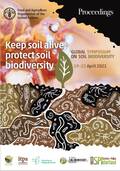Publications
Check the full list of the FAO’s Global Soil Partnership publications here
Proceedings of the Global Symposium on Soil Biodiversity 2021
The proceedings book of the GSOBI21 contains all papers presented both orally and in poster format during the symposium. The papers have provided sufficient scientific evidence that the loss of soil biodiversity is a global threat, and shows the place we are standing on and where we need to go to prevent soil biodiversity loss and to reinforce knowledge about soil biodiversity.
Keep soil alive, Protect soil biodiversity - GSOBI Outcome document Biodiversity
The Global Symposium on Soil Biodiversity outcome document highlights scientific evidence on the status of soil biodiversity, its impacts, and an agenda for action in the framework of achieving the SDGs. The recommendations presented in this document aim to support the development of policies and actions to encourage the full use of soil biodiversity in the various land-use sectors. The Global Symposium on Soil Biodiversity was held virtually on the FAO zoom platform from 19-22 April 2021. It was attended by over 5 000 participants representing more than 160 countries, including representatives of FAO members, organizing institutions, academia, research institutions, the private sector, civil society, and farmers.
The Magical World of Soil Biodiversity - Official launch on 19 April 2021
In the framework of World Soil Day 2020, FAO, the International Union of Soil Sciences (IUSS), and the Global Soil Partnership (GSP) launched a children's book contest on Soil Biodiversity with the motto "Keep soil alive, protect soil biodiversity". The soil biodiversity book highlights the importance of soil organisms and raises awareness of the urgent need to protect soil biodiversity among a young audience (children aged 6-11 years). This collection of 10 stories includes the best entries received from a total of 80 books spanning over 60 countries.
State of knowledge of soil biodiversity – Status, challenges and potentialities. Summary for policy makers
This summary for policy makers presents the key findings of the main report "State of knowledge of soil biodiversity - Status, challenges and potentialities. The document presents concisely the state of knowledge on soil biodiversity, the threats to it and the solutions that soil biodiversity can provide to problems in different fields.
State of knowledge of soil biodiversity – Status, challenges and potentialities.
There is increasing attention to the importance of biodiversity for food security and nutrition, especially above-ground biodiversity such as plants and animals. However, less attention is being paid to the biodiversity beneath our feet, soil biodiversity, which drives many processes that produce food or purify soil and water. This global report is the result of an inclusive process involving more than 300 scientists from around the world under the auspices of the FAO’s Global Soil Partnership and its Intergovernmental Technical Panel on Soils, the Convention on Biological Diversity, the Global Soil Biodiversity Initiative and the European Commission.
Code de conduite international sur l’utilisation et la gestion durables des engrais
Le Code de conduite vise à traiter des questions de portée mondiale et contribue ainsi à la réalisation de certains objectifs de développement durable (ODD). Il établit un cadre adaptable au contexte local, assorti d’un ensemble de pratiques d’application volontaire, au service des différents acteurs directement ou indirectement concernés par les engrais.
Status of the World's Biodiversity for Food and Agriculture
Based on information provided by 91 countries and 27 international organizations, analysis of global literature and datasets, and contributions from over 175 authors and reviewers, the State of the World's Biodiversity for Food and Agriculture assesses biodiversity for food and agriculture and its management worldwide.
Status of the World's Soil Resources
Main report
The SWSR is a reference document on the status of global soil resources that provides regional assessments of soil change. The information is based on peer-reviewed scientific literature, complemented with expert knowledge and project outputs. It provides a description and a ranking of ten major soil threats that endanger ecosystem functions, goods and services globally and in each region separately.
Directives volontaires pour une gestion durable des sols
Elles ont été adoptées par l’Assemblée plénière du Partenariat mondial sur les sols à sa quatrième session (Rome, 25 mai 2016), approuvées par le Comité de l’agriculture de la FAO à sa 25ème session (Rome, 28 septembre 2016) et enfin, entérinées par le Conseil de la FAO à sa 155ème session (Rome, 5 décembre 2016).
Les Directives volontaires pour une gestion durable des sols ont été élaborées dans le cadre d’un processus ouvert, au sein du Partenariat mondial sur les sols. Elles visent à servir de référence et à fournir à un vaste éventail de parties prenantes engagées des recommandations générales d’ordre technique et stratégique concernant la gestion durable des sols.
Charte mondiale des sols révisée
Des sols sains sont une condition préalable essentielle pour satisfaire divers besoins en nourriture, biomasse (énergie), fibre, fourrage et autres produits; et pour assurer la fourniture de services écosystémiques essentiels dans toutes les régions du monde. Cependant, les ressources en sol de l’humanité sont confrontées à des pressions sans précédent. Il s’agit notamment de diverses formes de dégradation des sols, dont l’imperméabilisation liée à une urbanisation rapide, qui ont de graves conséquences.
















